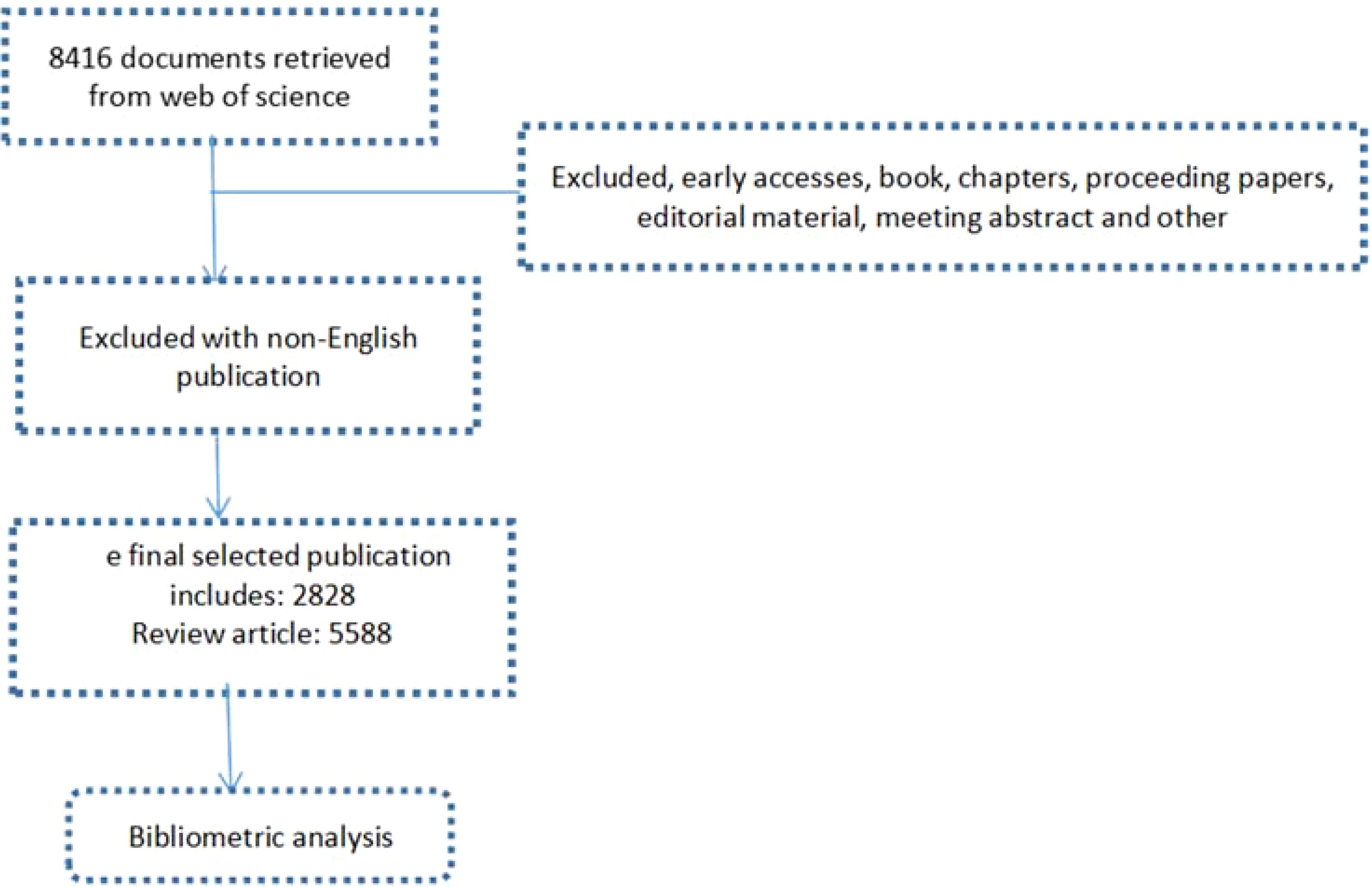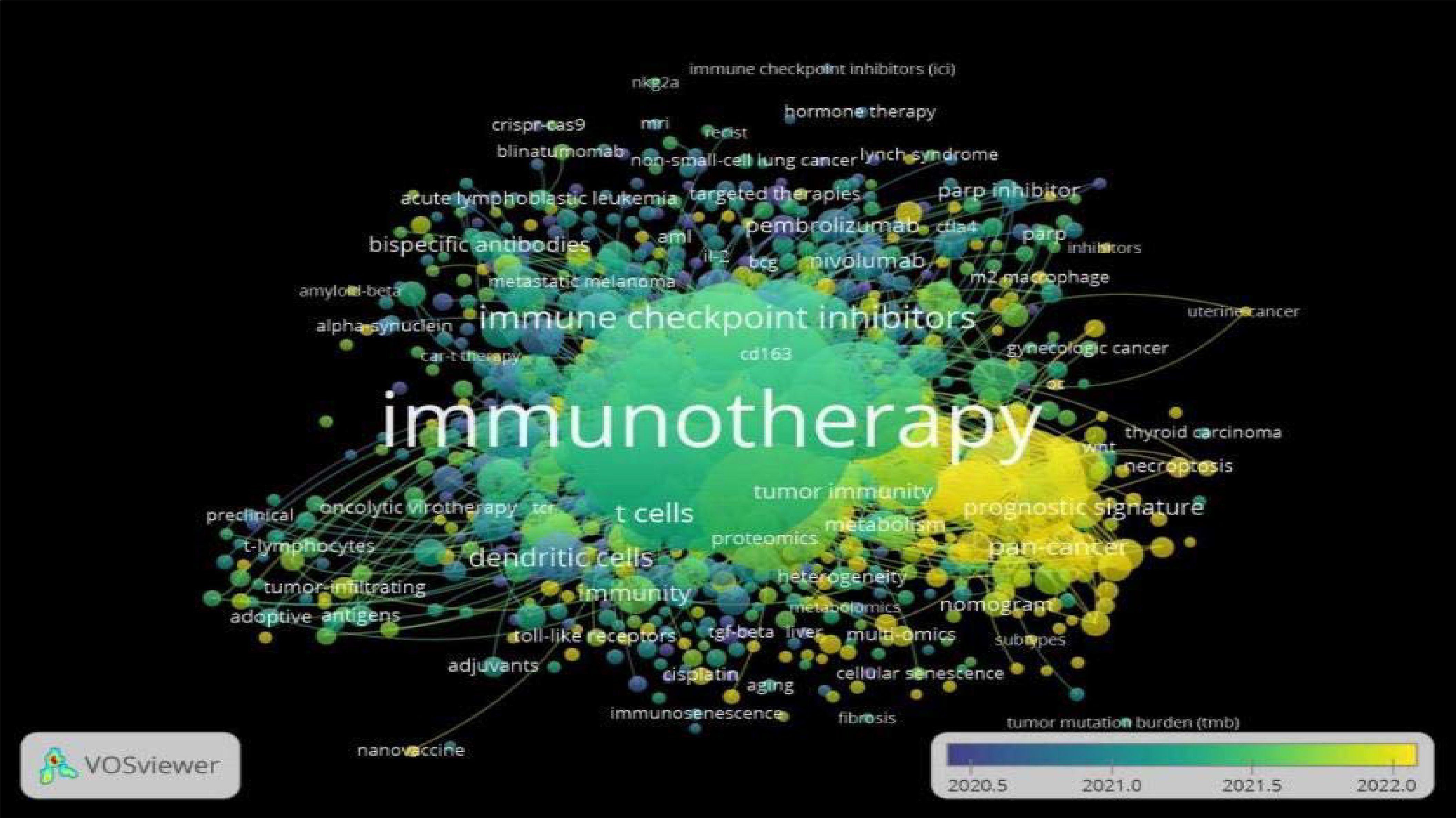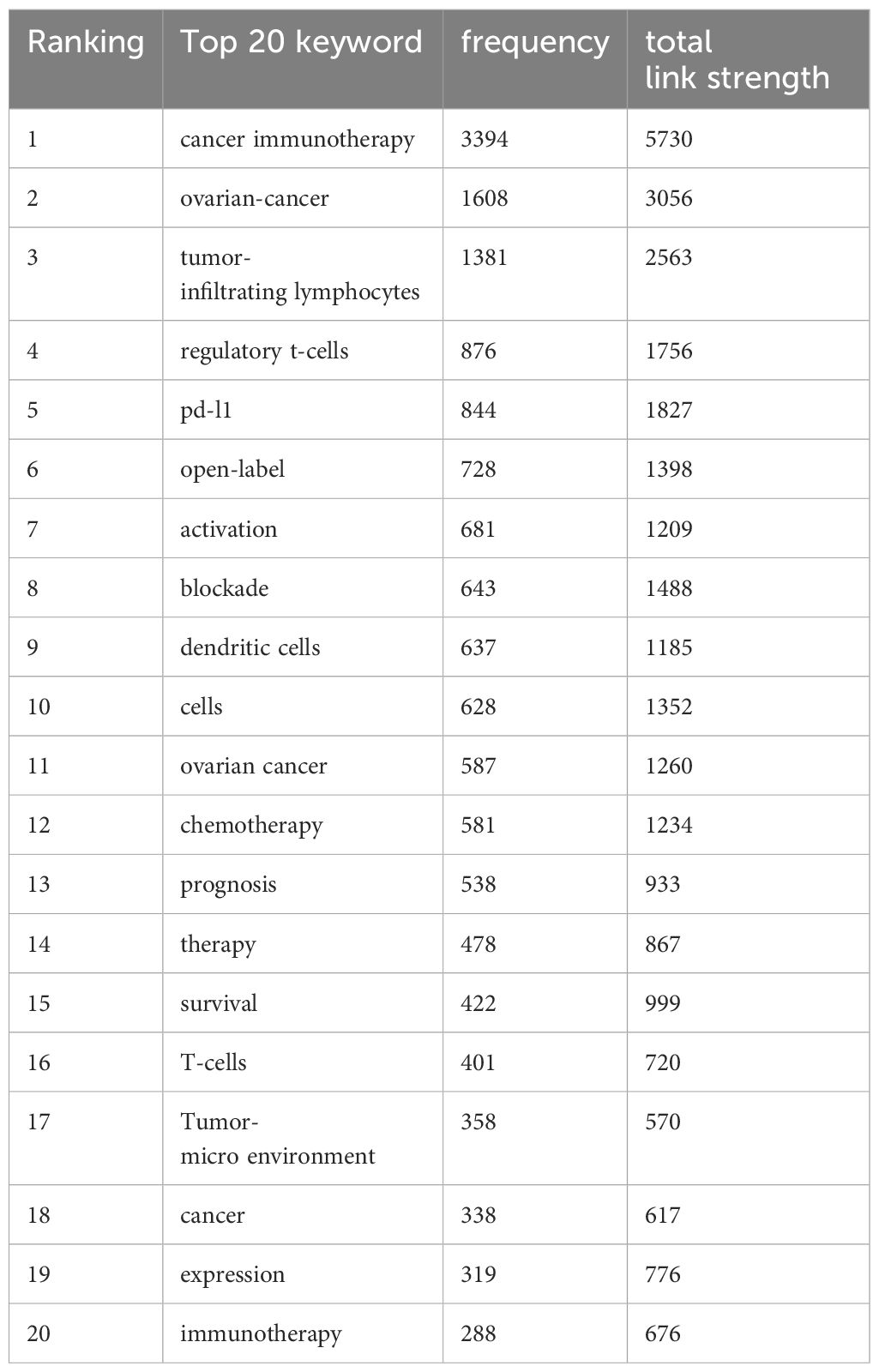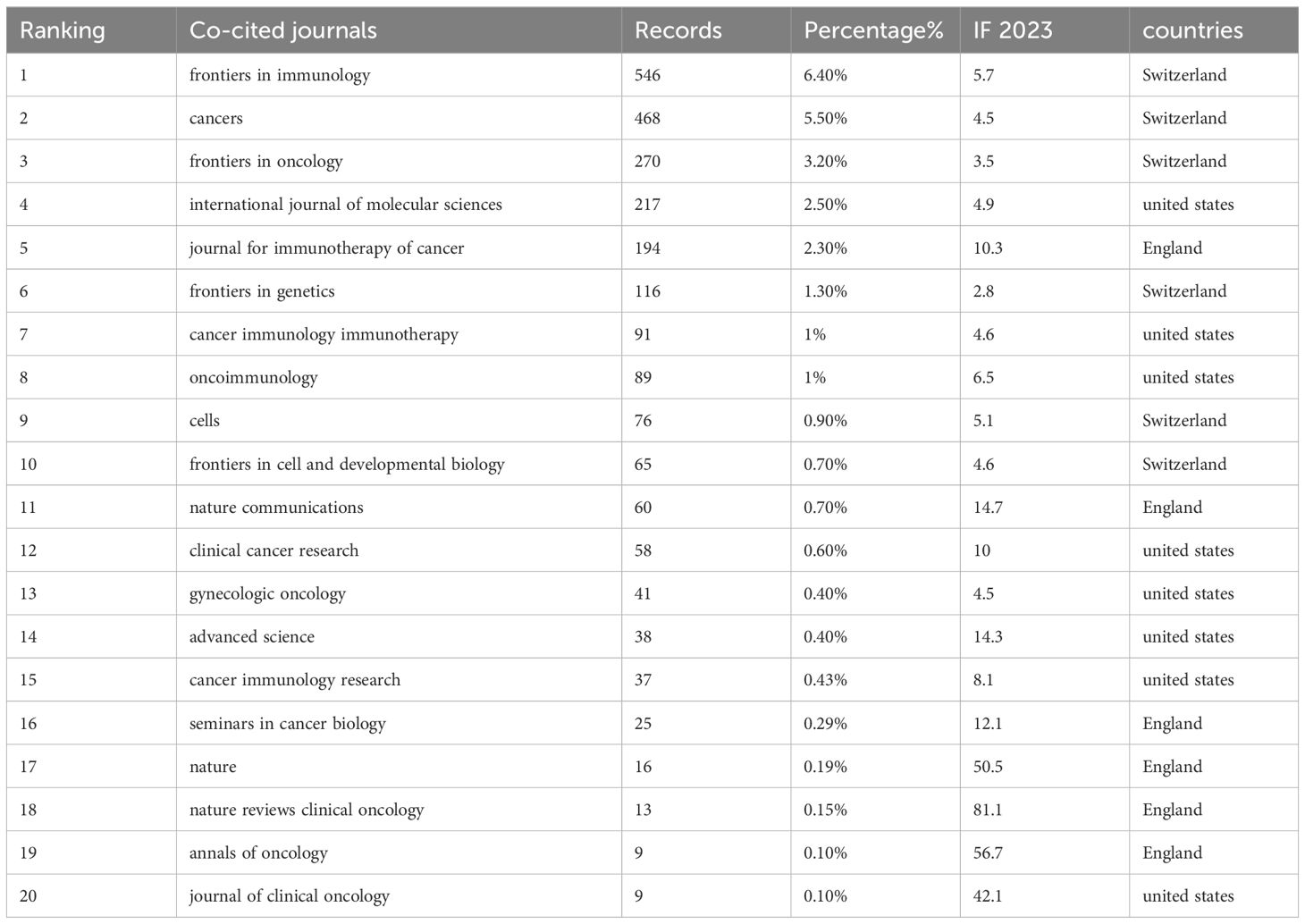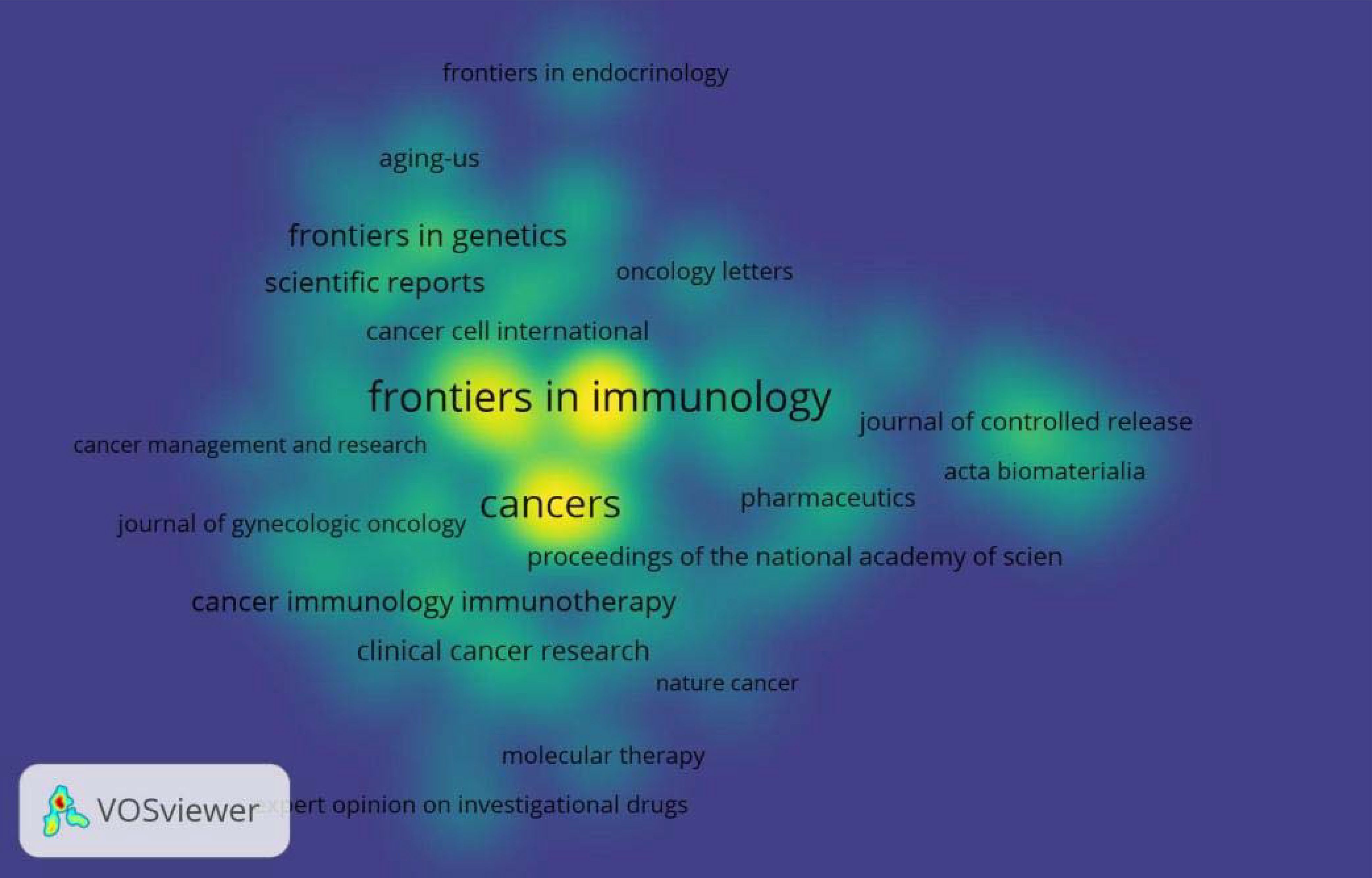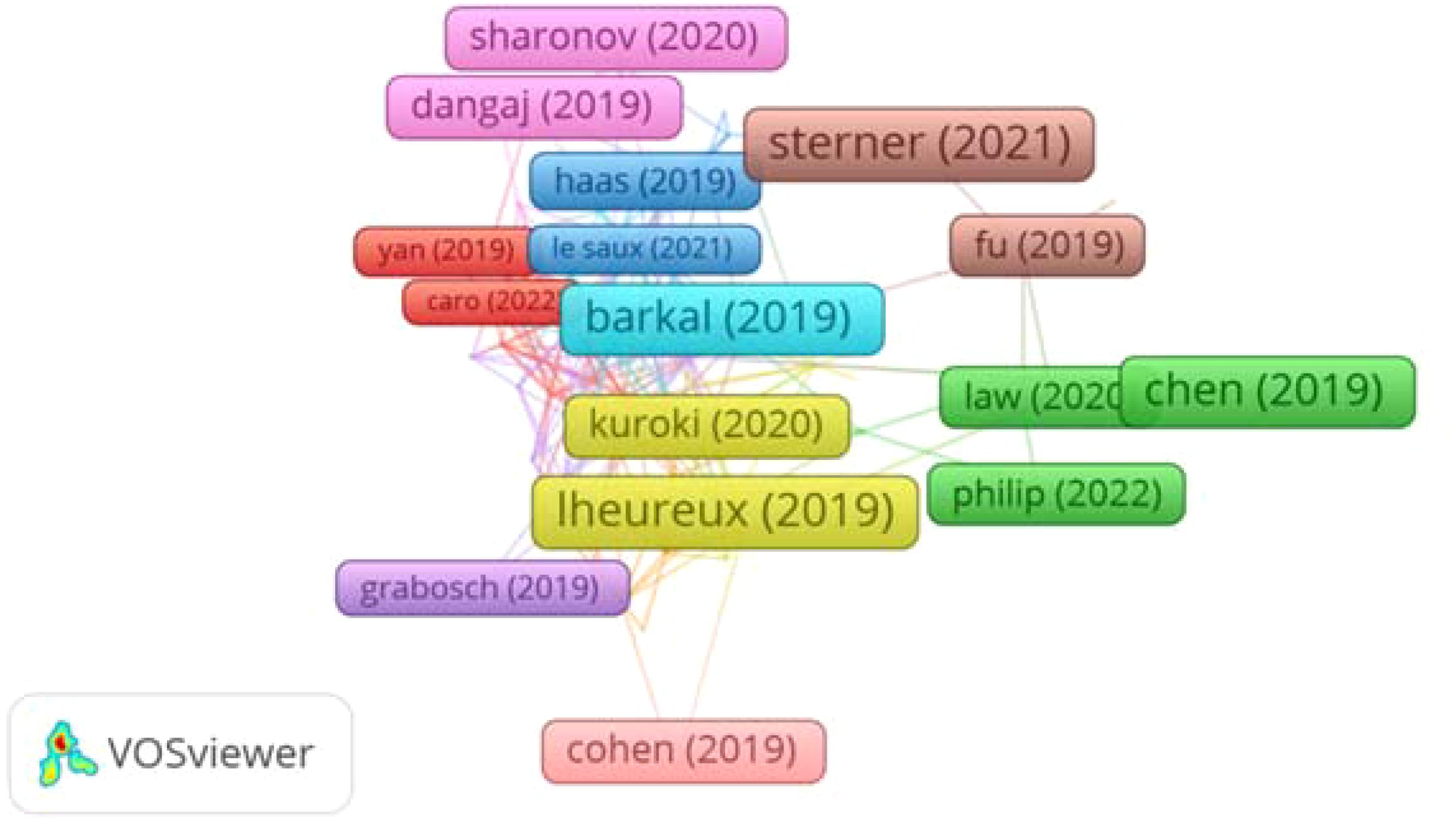- Department of Gynecology, First Affiliated Hospital of Wenzhou Medical University, Wenzhou, Zhejiang, China
Background: This study conducts a bibliometric literature analysis to explore trends in immunotherapy for ovarian cancer from 2019 to 2023.
Methods: An extensive online literature search was conducted in the Web of Science Core Collection database to identify English-language articles and reviews related to “trends in immunotherapy”, and “ovarian cancer”. statistical analysis was performed using VOSviewer to visualize and compare nations, institutions, and journals simultaneously.
Results: Our findings highlight contributions by 118 nations, led by the People’s Republic of China with 3,167 contributions; Germany followed with 558 and Italy having 547. Of all publications made between 2019-2023, “Frontiers Immunology” had the most publications with 546 total records followed by “cancers “, and “frontiers in oncology” being the most heavily relied upon categories. Annually publication trends increased until 2022 but then declined considerably as a peak of highly-cited papers occurring between 2019 and 2022.
Conclusions: Our bibliometric analysis not only maps the evolution of immunotherapy research in ovarian cancer but also provides actionable insights for advancing scientific progress. By identifying emerging trends and key areas, future research can strategically enhance treatment strategies and outcomes for ovarian cancer patients.
Introduction
Ovarian cancer is a significant health concern for women worldwide. Current estimates indicate that in 2020 each year over 300,000 new instances of ovarian cancer were identified, making up 3.4% of all newly diagnosed cancer cases and contributing to 4.7% of cancer-related deaths among women (1). In 2022, there were about twenty thousand new cases of ovarian cancer reported in the United States, leading to approximately twelve thousand eight hundred and ten deaths among women from the disease (2). Thereby most several risk factors associated with ovarian cancer, including excessive weight, breast cancer in the family, smoking, early or late menstruation, and reproductive issues (3). Due to nonspecific manifestations, over 70% of ovarian cancer cases are often detected at a late stage (4). In the majority of countries, the likelihood of survival rate for ovarian cancer is typically below 40 out of 100 (5). The lack of early and effective detection methods is the primary reason for the dismal prognosis and elevated mortality rate (6) The first-line and standard treatments for ovarian cancer (OC) include tumor removal surgery and platinum-based chemotherapy. Tumor removal surgery aims to ensure the maximum resection of all visible tumors and accurate tumor staging, with optimal debulking typically defined as having residual tumors less than 1 cm in diameter per nodule (7). Therefore, it is necessary to increase efforts to identify and understand novel immunotherapies and specific targeted therapies for ovarian cancer, as well as to develop more effective diagnostic and treatment strategies.
In the past decades, the application of immunotherapy has significantly expanded the scope of treatment methods, demonstrating favorable prognostic impacts across various types of cancers (8–10). However Ovarian cancer (OC) exhibits limited response to immunotherapy (11). Genome sequencing over the past decade has progressively revealed insights into OC (12). Identifying driver mutations in ovarian cancer (OC) using initiatives like the Cancer Genome Atlas (TGGA) provides novel therapeutic strategies (12). The predictive ability of immunotherapy outcomes can be improved by evaluating sensitive and resistant targeted therapy subgroups represented by biomarkers (11, 13). Further immunotherapy Treatments, such as adoptive T-cell therapy and vaccines, are currently under investigation (14). Bibliometrics is a key tool for evaluating scientific and technological progress, aiding in the exploration of both qualitative and quantitative research methods. Through systematic investigation, it clarifies data characteristics within the designated research field and depicts research content and trends via knowledge graphs (15–17). This method involves selecting articles within a specific research field and analyzing various aspects, such as the country, author, keyword, publishing agency, and journals by utilizing VOSviewer (18). Our study aimed to explore knowledge mapping and trends visualization in the field of immunotherapy for ovarian cancer over the past five years. Using Web of Science database, we investigated document systems and measurement methodologies as a research area, employing quantitative research methods to analyze the distribution, relationships, and changes across various domains.
Materials and methods
Data source
This study utilizes data from the Core Collection of Web of science), focusing specifically on studies, including both articles and reviews, published between January 1, 2019, and December 31, 2023, exclusively in English. The formula of searching: TS = [“ovarian cancer” OR “ovarian tumor” OR “ovarian neoplasm” OR “malignant neoplasm of ovarian”] AND “immunotherapy” OR “immunotherapeutic” OR “immunotherapeutic response” OR “immunotherapeutic target”]. the specific process outlined in the flowchart is shown in Figure 1.
The search terms employed in this study were meticulously selected to formulate a comprehensive search strategy aimed at encompassing a broad spectrum of literature relevant to trends in immunotherapy for ovarian cancer.
Data analysis
We downloaded data in TXT format from the Web of Science, and used VOSViewer version 1.6.20, as a software application that generates maps of scholarly works. VOSviewer focuses on a graphical representation to illustrate bibliometric relationships within its user interface (18). This tool facilitated the creation of network visualization maps for analyzing co-authorship, co-occurrence, and co-cited entities, including countries/regions, institutions, authors, and keywords of interest. In these visualization maps, node size corresponds to the frequency of relevant elements, chain thickness indicates the strength of connections, and node color represents affiliation with distinct modules. This approach enables a comprehensive examination of collaborative relationships, thematic intersections, and influential entities within the scholarly landscape, thereby enhancing our understanding of research network dynamics on a broader scale.
Data mapping
VOS viewer software was employed for the generation of visualizations depicting the results of co-occurrence data analysis. The presented visual representation takes the form of a map, showcasing each keyword in distinct colors. The size of individual keyword clusters on the map correlates directly with their frequency of appearance in the article. Additionally, the spatial closeness of two keywords on the visualization map functions as an indicative measure of their co-occurrence. This method of visualization provides a nuanced understanding of the interrelationships between keywords, facilitating the identification of thematic concentrations and patterns emerging from the analyzed data.
Bibliometric assessment
This article offers a thorough review and assessment of the research topic, conducting in-depth analyses of publishing models, institutional influences, country trends, keyword usage, and author patterns. The evaluation explores the intricacies of academic contributions, institutional impacts, and regional disparities, unveiling essential dimensions that mold the research landscape within specific fields. The adoption of bibliometric methods serves as a robust framework for systematically gauging academic impact and discerning significant trends. This approach contributes to a detailed understanding of research prospects associated with the examined topic, providing valuable insights for the scholarly community and practitioners alike.
Results
Annual publication trends
In our study, 8416 articles were incorporated, encompassing 5,588 research articles and 2,828 reviews with a focus on immunotherapy and ovarian cancer. The volume of publications related to immunotherapy and ovarian cancer exhibited an upward trajectory from 2019 to 2022. Notably, the data reveals a downturn in publications for the year 2023. Within the year 2022, a pinnacle was reached with a publication count of 2,106 articles, marking it as the year with the highest scholarly output. However, in 2023, a noticeable decline in the number of publications became apparent. A comprehensive depiction of this information is elucidated in Figure 2, providing a visual representation of the temporal trends in the scholarly contributions to the field.
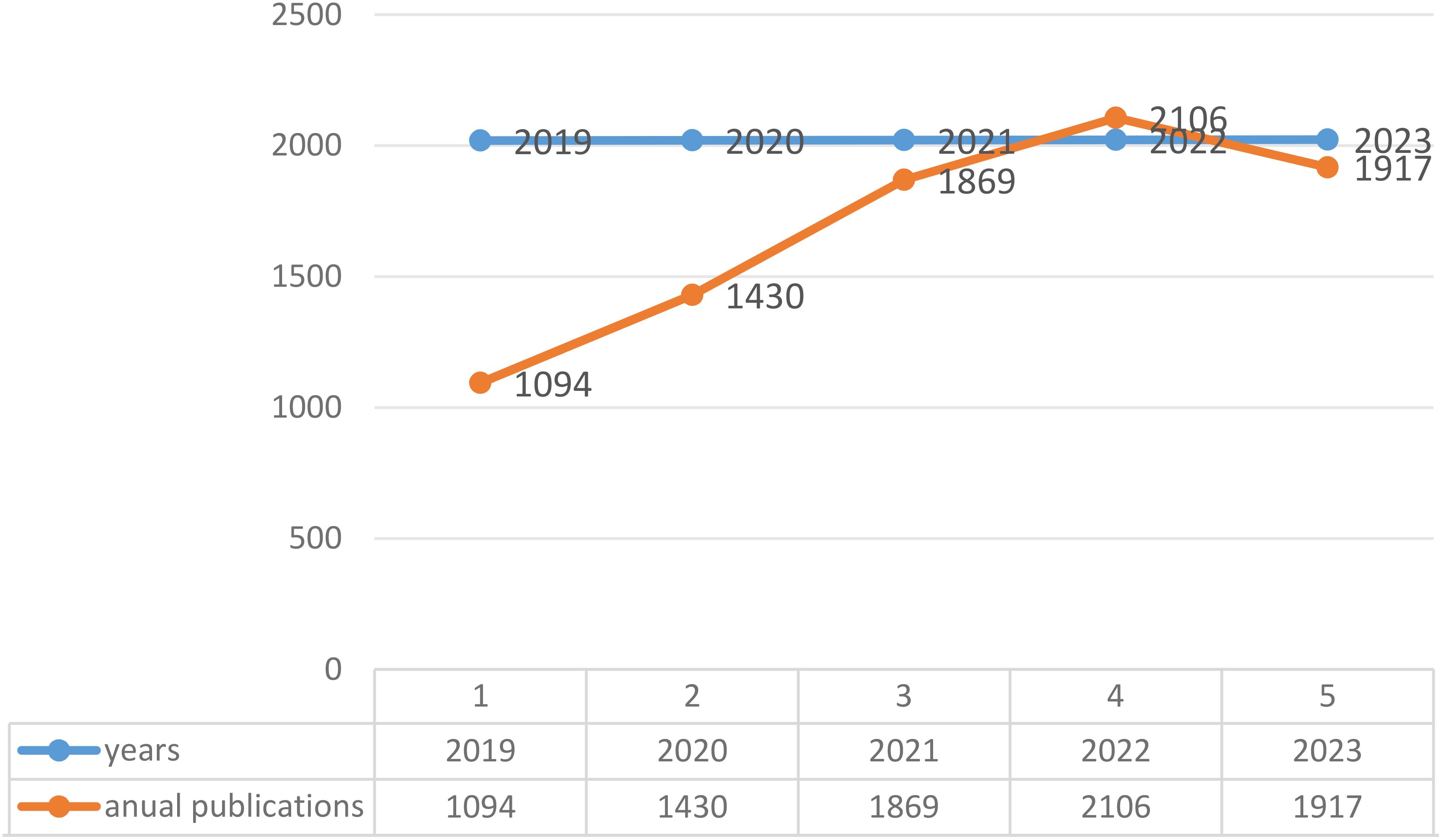
Figure 2. Annual publication representation of the temporal trends in the scholarly contributions to the field.
Author insight analysis
Throughout the period from 2019 to 2023, a total of 48,238 authors have actively contributed to publications within the designated topic. Figure 3B delineates the top 20 authors, ranked according to their prolificacy in the realm of immunotherapy and ovarian carcinoma research. Notably, Zhang Y emerges as a frontrunner, boasting an impressive 125 published documents, exemplifying a substantial impact on the field. Close behind is Wang Y with 106 publications, securing the second position, while LiY occupies the third position with 84 publications. To provide a visual representation of the collaborative ties among these leading authors, Figure 3A illustrates the co-authorship connections within the top 20 authors in this comprehensive study.
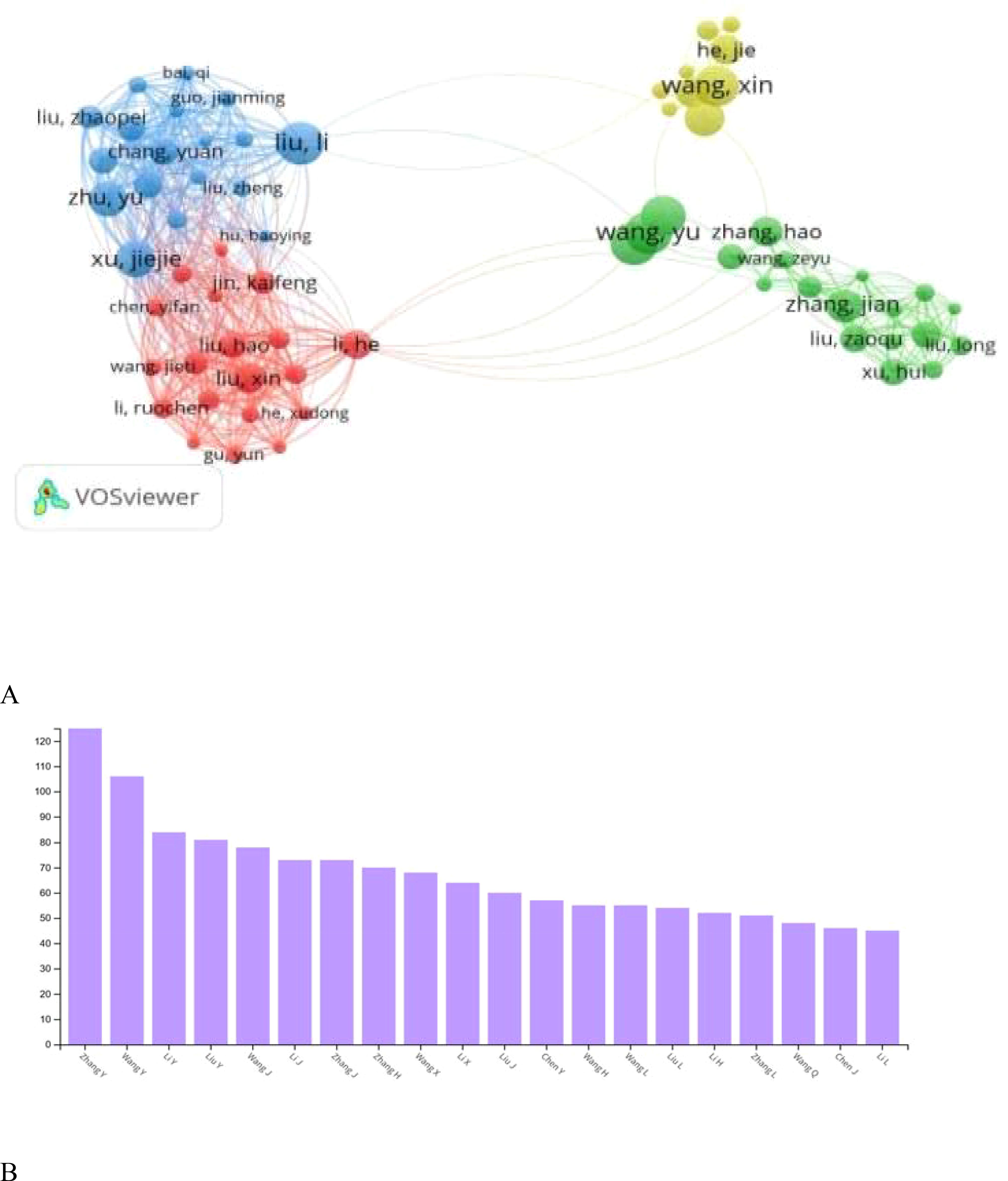
Figure 3. (A) Shows cross-citing relationships, and network visualization among Authors, while (B) shows the publishing productivity of different authors expressed as the number of publications.
Analyzing contributions of different regions/countries
Over the last five years,118 nations have Provided contributions to the publication of papers in the designated Domain. Figure 4B provides an overview of the top 20 countries, systematically ranked based on their publication counts. The People’s Republic of China secures the foremost position with an impressive 3,167 publications, demonstrating a substantial research output. Following closely is Germany, contributing significantly with 558 publications, and Italy claiming the third position with 547 publications. Other notable contributors include England, Canada, and France, each presenting a substantial number of publications with 342, 284, and 268 documents, respectively. Additionally, South Korea, Netherlands, Spain, and Japan stand out among the top 20 countries in terms of scholarly contributions. To visually elucidate the collaborative connections between countries, Figure 4A offers a comprehensive representation of co-authorship networks within this global research landscape.
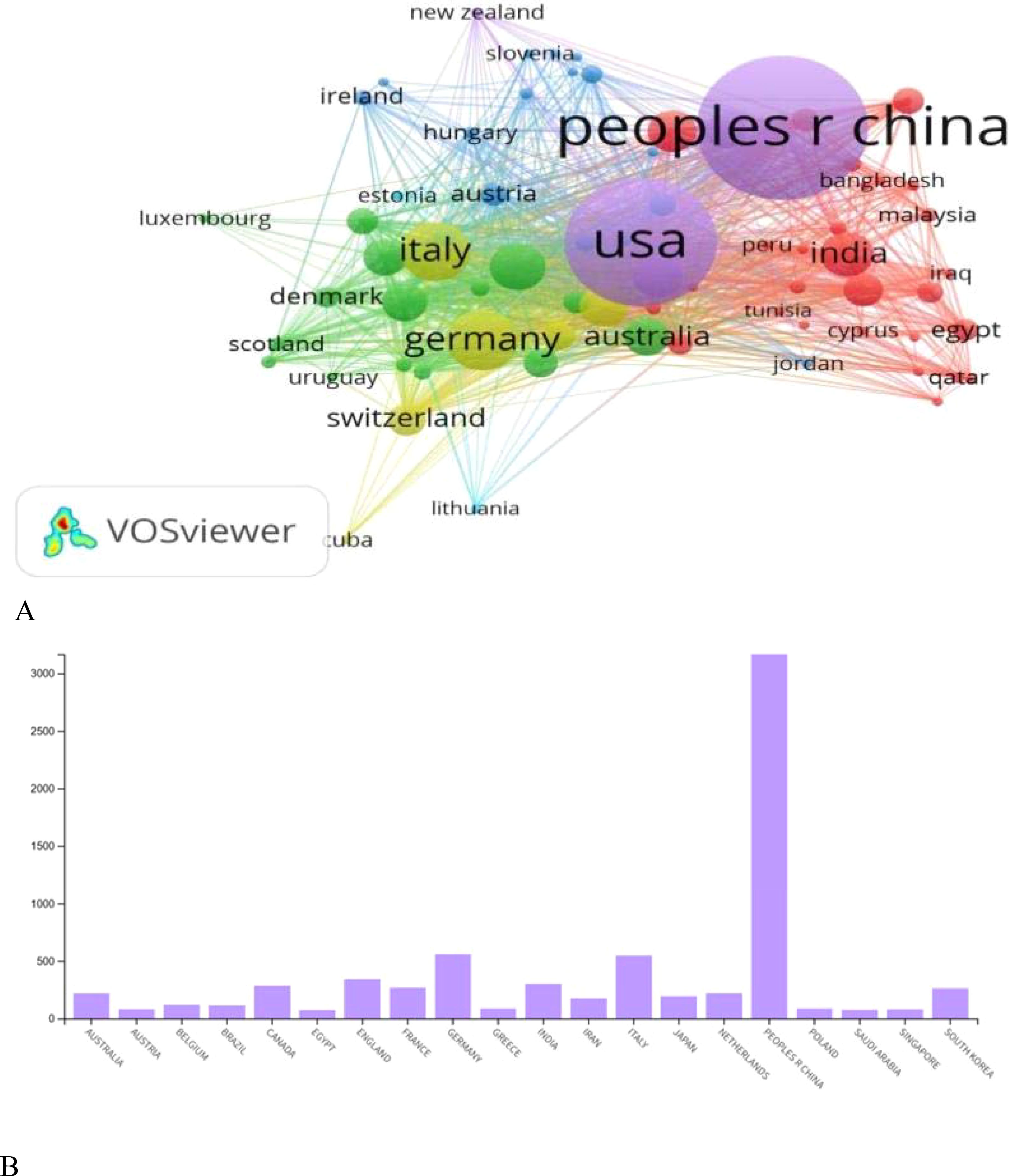
Figure 4. (A) Illustrates a network visualization map of the co-authorship networks among the countries, while (B) shows the most published regions and their publication numbers.
Institutional contributions analysis in the publication
The institution boasting the highest volume of publications is the University of Taxes, having authored 241 articles, constituting a substantial proportion of the overall publications. The People’s Republic of China occupies 10 positions within the top 20 institutions, contributing 1,668 articles. Following closely in the second and third positions are the United States of America and Germany, respectively. Figure 5A visually articulates the correlation between the timeline and the volume of articles produced. The top 5 institutions, contributing significantly to the scholarly output, include University of Texas, Harvard University, Fudan University, University of California, and Shanghai Jiao Tong University. Figure 5B shows the top 20 most highly active institutions in the field, further emphasizing the influential contributions of these institutions.
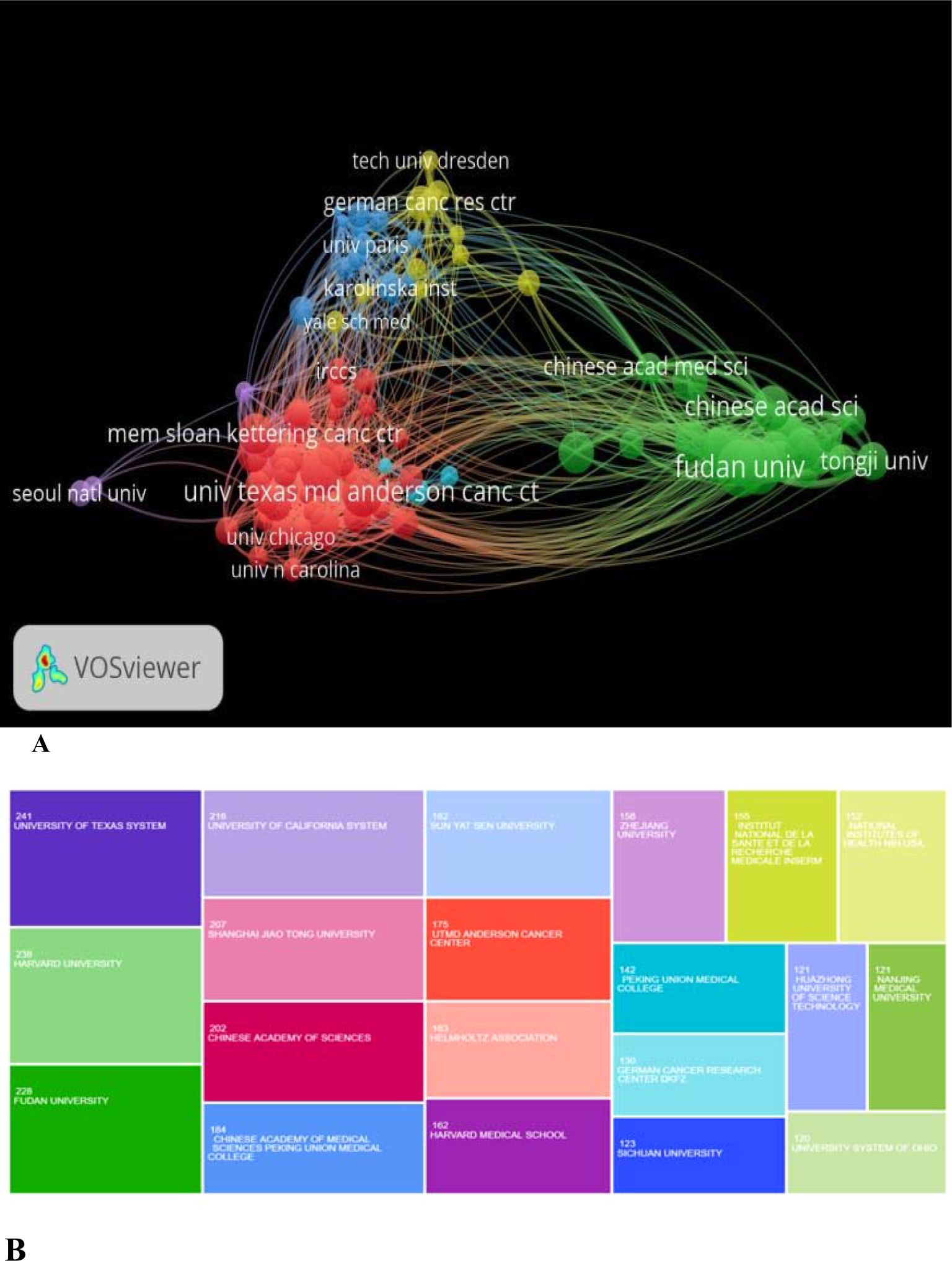
Figure 5. (A) Illustrates the co-authorship networks among these institutions, while (B) shows the most highly active institutions in the field and their number of publications per institute.
Analytic keywords
A total of 12,732 keywords are presented in Figure 6. The keywords were categorized into four distinct and color-coded clusters following keyword clustering analysis: blue, purple, green, and yellow. The dark blue cluster primarily encompasses terms like ‘immune checkpoint inhibitors’, ‘CRISPR-Cas9’, and ‘blinatumomab’. These terms were frequently used around mid-2020. the light blue cluster, keywords include terms like ‘t cells’, ‘dendritic cells’, and ‘tumor-infiltrating’. These terms were prevalent from early 2021 to mid-2021. The purple cluster includes terms like ‘PARP inhibitors, ‘hormone therapy’, and ‘targeted therapies. These terms used slightly more recently than the dark blue cluster, around late 2020 to early 2021. The green cluster keyword includes terms like ‘immunotherapy’, ‘adjuvants’, and ‘Nano vaccine’. These terms are commonly used around mid-2021 to early 2022. While the yellow cluster keywords include terms like ‘pan-cancer’, ‘prognostic signature’, and ‘necroptosis’. These terms indicate that have become prominent more recently, closer to 2022. This analytical approach provides a comprehensive understanding of key themes and concepts in the trend of immunotherapy in ovarian cancer. The visually represented clusters aid in identifying cohesive groups of keywords, assisting researchers in navigating and comprehending the multifaceted landscape of this scholarly domain. Table 1 highlights the top 20 keywords in cancer immunotherapy research.
Contribution of journals
It is estimated that 15,09 journals have disseminated Documents associated with this topic, with Table 2 highlighting the top 20 most productive journals for immunotherapy and ovarian cancer research. Leading the list is the Journal of Frontiers Immunology, contributing a noteworthy 546 publications (IF=5.7, 6.40%). Following closely is the Cancers Journal (IF=4.5, 5.5%) and Frontiers in Oncology (IF=3.5, 3.2%) with 468 and 270 publications, respectively. International journal of Molecular Sciences ranks as the fourth most published journal with 217 publications, succeeded by the Journal for Immunotherapy of Cancer with 194 publications. The Nature Reviews Clinical Oncology Journal boasts the top-related impact factor (IF: 81.1), afterward annals of oncology (IF=56.7). The United States of America claims 8 positions within the top 20 most co-cited journals in this field. Figure 7 provides a visualization map illustrating the contribution of journals, offering a dynamic representation of their interconnection and impact within the scholarly landscape.
Document analysis
In the past five years, 8,416 documents and papers have been Published in the field of immunotherapy for ovarian carcinoma. Table 3 presents 20 of the most extensively cited documents, highlighting the impactful contributions within the scholarly landscape. The document titled “CAR-T cell therapy: current limitations and potential strategies” holds the leading position, published in the Blood Cancer Journal in 2021 with an impact factor of 12.9 and accumulating 889 citations. This groundbreaking study emphasizes immunotherapy’s significance as a crucial cancer treatment. Following closely is the second most cited document, “Epithelial ovarian cancer: Evolution of management in the era of precision medicine” published in Cancer Journal for Clinicians New in 2019, boasting an impact factor of 503.1 and garnered 841 citations. This document presents a comprehensive overview of advancements in managing epithelial ovarian cancer, particularly in precision medicine.
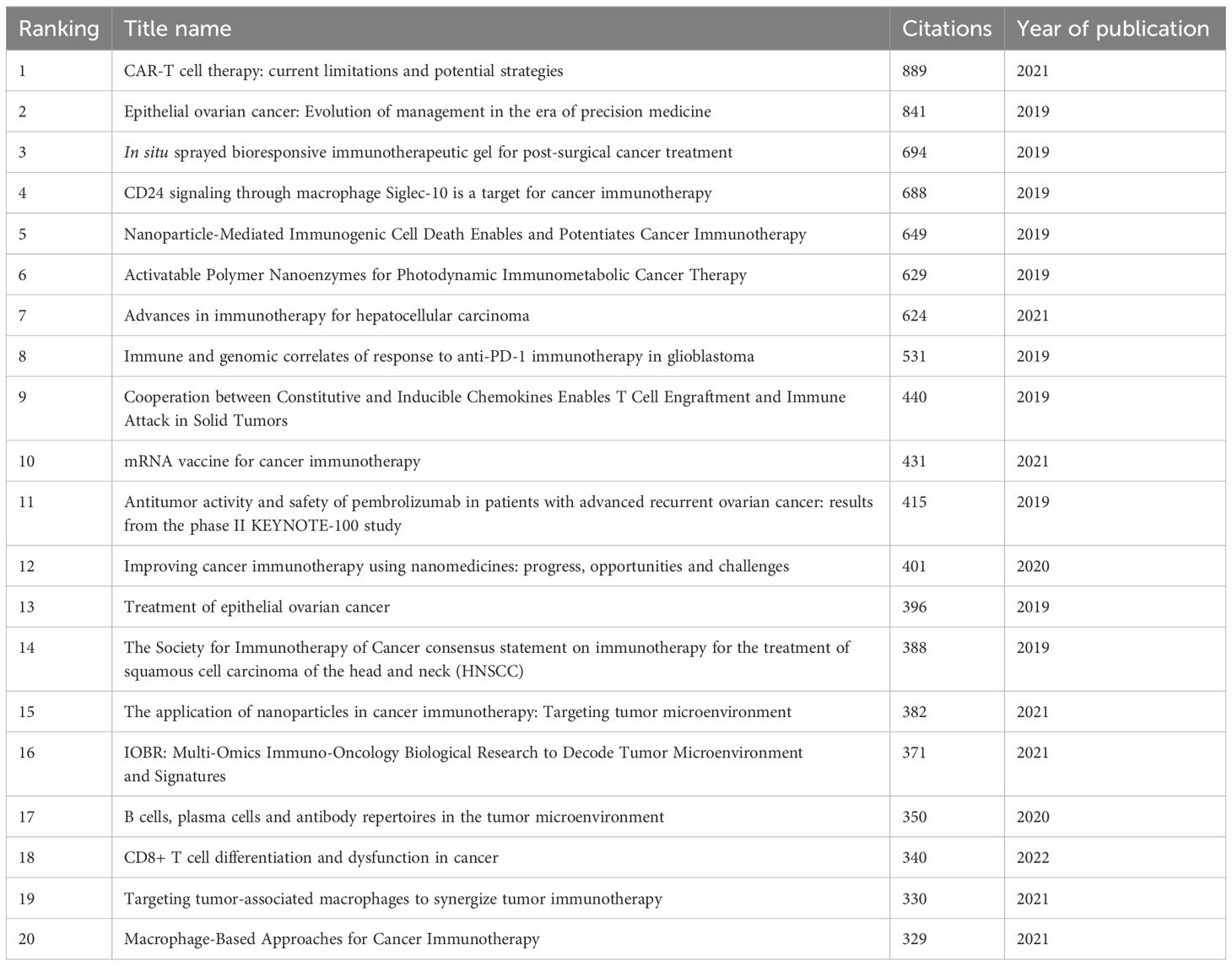
Table 3. Presents a list of the 20 most widely cited documents in the field of cancer immunotherapy research from 2019 -2023.
Ranked third is the document titled “In situ sprayed bio responsive immunotherapeutic gel for post-surgical cancer treatment,” published in Nature Nanotechnology in 2019, holding an impact factor of 38.1, it has accumulated 694 citations. This report explores innovative post-surgical treatments using bio-responsive immunotherapeutic gels, offering promising strategies for improving patient outcomes. Figure 8 visually presents knowledge maps of these widely referenced documents, offering a comprehensive overview of their interconnected themes and contributions. This visualization aids in understanding the key areas of focus and the relationships between influential studies in the field.
Discussion
Immunotherapy has revolutionized tumor treatment by targeting key immune evasion mechanisms and stimulating CD8+ T cells to eliminate tumor cells. Across various cancers, like melanoma, colorectal cancer, and lung cancer, immune checkpoint inhibitors including anti-PD-1/PD-L1, anti-CTLA-4, and anti-Tim3, has significantly enhanced progression-free and overall survival rates. This success underscores their potential for ovarian cancer treatment, given its immunogenic nature. Biomarkers such as Regulatory T cells (Tregs), tumor-infiltrating lymphocytes (TILs), natural killer cells, and tumor-associated macrophages (TAMs) have been identified in blood, ovarian cancer tissue, and abdominal fluid, highlighting their role in immune response (19–25).
Nivolumab is the first clinically validated immune checkpoint inhibitor (ICI) for advanced cancer, and subsequent trials have further established the effectiveness of ICIs, in treating advanced and recurrent ovarian cancer (26–30). However, ICIs have demonstrated limited effectiveness in newly diagnosed ovarian cancer due to compensatory immune checkpoint mechanisms that restrict monotherapy efficacy (31, 32).
Our research provides unique insights and perspectives that contribute novel ideas to the field of immunotherapy and ovarian cancer treatment research. By conducting an exhaustive bibliometric analysis of trends of immunotherapy in OC literature published over the past five years, we offer an unparalleled view of research in this domain. This evaluation represents the first-ever ovarian cancer immunotherapy in bibliometrics; thus, demonstrating its groundbreaking significance within its field. By reviewing 8416 articles and reviews, Publications can have a profound effect on the productivity and progress of an area of study. We provide an in-depth view of research trends, prominent authors, and potential research gaps. The knowledge mapping and visualization aspects of our analysis reveal several important trends and transformations in the research field. For instance, there is a notable increase in focus on combination therapy, the utilization of biomarkers for treatment response prediction, and the geographical distribution of research activities. These visualizations not only aid in comprehending the current research landscape but also highlight areas that warrant further attention and remain underexplored. One of the main contributions of our study is the comprehensive examination and potential future directions of ovarian cancer immunotherapy. By analyzing complex immunogenic therapies for OC, we provide novel insights for reversing immune responses and identifying populations that may benefit from immunotherapy. Specifically, our study explores the combination of immune checkpoint inhibitors with other therapeutic approaches, such as vaccines, to enhance treatment efficacy. Furthermore, our study highlights potential biases and limitations present within existing bodies of literature. As we relied solely on Web of Science database and English language publications for research purposes, this could have caused us to miss important studies published in other languages or indexed in different databases.
Conclusion
Using VOS Viewer 1.6.20 we explore trends and the status of immunotherapy research and ovarian cancer screening over the past five years, with a particular focus on contributions from the People’s Republic of China and Germany, both of which have been significant in this field. International cooperation played an essential role. As expected, the volume of research in this area continues to grow steadily over time. Prominent authors such as Zhang Y and Wang Y have emerged as frontrunners in this field, collectively contributing to an impressive 231 published documents during this period. Journal of Frontiers Immunology and Cancers in Switzerland Was among the top publications according to volume ranking. In terms of Citation rankings, the two most-cited articles ‘CAR-T cell therapy: current limitations and potential strategies; and Epithelial ovarian cancer: Evolution of management in the era of precision medicine.’ terms like ‘pan-cancer’, ‘prognostic signature’, and ‘necroptosis’ have emerged as significant indicators of hotspots in this field. These latest keywords highlight areas suitable for further investigation and guide researchers in determining priority research topics. In addition, identifying these hotspots is crucial for informing funding allocation decisions, ensuring that resources are directed toward the most promising and influential research areas. By focusing on these emerging trends and key areas, future research can strategically advance scientific progress in immunotherapy for OC and improve patient prognosis.
Data availability statement
The datasets presented in this study can be found in online repositories. The names of the repository/repositories and accession number(s) can be found below: https://webofscience.clarivate.cn/wos/woscc/summary/53fd6b71-1c72-46c4-9b85-ef630c7eb651-f5007bc3/relevance/1.
Author contributions
KS: Conceptualization, Formal analysis, Methodology, Software, Visualization, Writing – original draft, Writing – review & editing. LS: Conceptualization, Formal Analysis, Supervision, Writing – review & editing. WY: Conceptualization, Data curation, Validation, Writing – review & editing. HM: Writing – review & editing. FR: Writing – review & editing. HY: Investigation, Supervision, Writing – review & editing.
Funding
The author(s) declare financial support was received for the research, authorship, and/or publication of this article. This work was supported by Zhejiang Provincial Traditional Chinese Medicine Science and Technology Program, (2023ZL509), Zhejiang Provincial Clinical Research Center for Obstetrics and Gynecology.
Conflict of interest
The authors declare that the research was conducted in the absence of any commercial or financial relationships that could be construed as a potential conflict of interest.
Publisher’s note
All claims expressed in this article are solely those of the authors and do not necessarily represent those of their affiliated organizations, or those of the publisher, the editors and the reviewers. Any product that may be evaluated in this article, or claim that may be made by its manufacturer, is not guaranteed or endorsed by the publisher.
References
1. Sung H, Ferlay J, Siegel RL, Laversanne M, Soerjomataram I, Jemal A, et al. Global cancer statistics 2020: GLOBOCAN estimates of incidence and mortality worldwide for 36 cancers in 185 countries. CA Cancer J Clin. (2021) 71:209–49. doi: 10.3322/caac.21660
2. Ovarian Cancer Statistics | How Common is Ovarian Cancer (2024). Available online at: https://www.cancer.org/cancer/types/ovarian-cancer/about/key-statistics.html.
3. Torre LA, Islami F, Siegel RL, Ward EM, Jemal A. Global cancer in women: burden and trends. Cancer Epidemiol biomark Prev Publ Am Assoc Cancer Res Cosponsored Am Soc Prev Oncol. (2017) 26:444–57. doi: 10.1158/1055-9965.epi-16-0858
4. Maringe C, Walters S, Butler J, Coleman MP, Hacker N, Hanna L, et al. Stage at diagnosis and ovarian cancer survival: evidence from the International Cancer Benchmarking Partnership. Gynecol Oncol. (2012) 127:75–82. doi: 10.1016/j.ygyno.2012.06.033
5. Allemani C, Weir HK, Carreira H, Harewood R, Spika D, Wang XS, et al. Global surveillance of cancer survival 1995-2009: analysis of individual data for 25,676,887 patients from 279 population-based registries in 67 countries (CONCORD-2). Lancet Lond Engl. (2015) 385:977–1010. doi: 10.1016/s0140-6736(14)62038-9
6. Jayson GC, Kohn EC, Kitchener HC, Ledermann JA. Ovarian cancer. Lancet Lond Engl. (2014) 384:1376–88. doi: 10.1016/S0140-6736(13)62146-7
7. Fader AN, Rose PG. Role of surgery in ovarian carcinoma. J Clin Oncol Off J Am Soc Clin Oncol. (2007) 25:2873–83. doi: 10.1200/jco.2007.11.0932
8. Wang YC, Wang X, Yu J, Ma F, Li Z, Zhou Y, et al. Targeting monoamine oxidase A-regulated tumor-associated macrophage polarization for cancer immunotherapy. Nat Commun. (2021) 12:3530. doi: 10.1038/s41467-021-23164-2
9. González-Martín A, Sánchez-Lorenzo L. Immunotherapy with checkpoint inhibitors in patients with ovarian cancer: Still promising? Cancer. (2019) 125 Suppl 24:4616–22. doi: 10.1002/cncr.32520
10. Tu L, Guan R, Yang H, Zhou Y, Hong W, Ma L, et al. Assessment of the expression of the immune checkpoint molecules PD-1, CTLA4, TIM-3 and LAG-3 across different cancers in relation to treatment response, tumor-infiltrating immune cells and survival. Int J Cancer. (2020) 147:423–39. doi: 10.1002/ijc.32785
11. Morand S, Devanaboyina M, Staats H, Stanbery L, Nemunaitis J. Ovarian cancer immunotherapy and personalized medicine. Int J Mol Sci. (2021) 22. doi: 10.3390/ijms22126532
12. Xie K, Fu C, Wang S, Xu H, Liu S, Shao Y, et al. Cancer-testis antigens in ovarian cancer: implication for biomarkers and therapeutic targets. J Ovarian Res. (2019) 12:1. doi: 10.1186/s13048-018-0475-z
13. Liu Q, Yang X, Yin Y, Zhang H, Yin F, Guo P, et al. Identifying the role of oxidative stress-related genes as prognostic biomarkers and predicting the response of immunotherapy and chemotherapy in ovarian cancer. Oxid Med Cell Longev. (2022) 2022:6575534. doi: 10.1155/2022/6575534
14. Saux OL, Ray-Coquard I, Labidi-Galy SI. Challenges for immunotherapy for the treatment of platinum resistant ovarian cancer. Semin Cancer Biol. (2021) 77:127–43. doi: 10.1016/j.semcancer.2020.08.017
15. Chen C, Dubin R, Kim MC. Emerging trends and new developments in regenerative medicine: a scientometric update (2000 - 2014). Expert Opin Biol Ther. (2014) 14:1295–317. doi: 10.1517/14712598.2014.920813
16. He Z, Lin M, Xu Z, Yao Z, Chen H, Alhudhaif A, et al. Deconv-transformer (DecT): A histopathological image classification model for breast cancer based on color deconvolution and transformer architecture. Inf Sci. (2022) 608:1093–112. doi: 10.1016/j.ins.2022.06.091
17. Chen Y, Lin M, Zhuang D. Wastewater treatment and emerging contaminants: Bibliometric analysis. Chemosphere. (2022) 297:133932. doi: 10.1016/j.chemosphere.2022.133932
18. van Eck NJ, Waltman L. Software survey: VOSviewer, a computer program for bibliometric mapping. Scientometrics. (2010) 84:523–38. doi: 10.1007/s11192-009-0146-3
19. Larkin J, Chiarion-Sileni V, Gonzalez R, Grob JJ, Rutkowski P, Lao CD, et al. Five-year survival with combined nivolumab and ipilimumab in advanced melanoma. N Engl J Med. (2019) 381:1535–46. doi: 10.1056/nejmoa1910836
20. André T, Shiu KK, Kim TW, Jensen BV, Jensen LH, Punt C, et al. Pembrolizumab in microsatellite-instability-high advanced colorectal cancer. N Engl J Med. (2020) 383:2207–18. doi: 10.1056/NEJMoa2017699
21. Giuntoli RL 2nd, Webb TJ, Zoso A, Rogers O, Diaz-Montes TP, Bristow RE, et al. Ovarian cancer-associated ascites demonstrates altered immune environment: implications for antitumor immunity. Anticancer Res. (2009) 29:2875–84.
22. Santoiemma PP, Reyes C, Wang LP, McLane MW, Feldman MD, Tanyi JL, et al. Systematic evaluation of multiple immune markers reveals prognostic factors in ovarian cancer. Gynecol Oncol. (2016) 143:120–7. doi: 10.1016/j.ygyno.2016.07.105
23. Reck M, Rodríguez-Abreu D, Robinson AG, Hui R, Csőszi T, Fülöp A, et al. Pembrolizumab versus chemotherapy for PD-L1-positive non-small-cell lung cancer. N Engl J Med. (2016) 375:1823–33. doi: 10.1056/nejmoa1606774
24. Toker A, Nguyen LT, Stone SC, Yang SYC, Katz SR, Shaw PA, et al. Regulatory T cells in ovarian cancer are characterized by a highly activated phenotype distinct from that in melanoma. Clin Cancer Res Off J Am Assoc Cancer Res. (2018) 24:5685–96. doi: 10.1158/1078-0432.ccr-18-0554
25. Larionova I, Tuguzbaeva G, Ponomaryova A, Stakheyeva M, Cherdyntseva N, Pavlov V, et al. Tumor-associated macrophages in human breast, colorectal, lung, ovarian and prostate cancers. Front Oncol. (2020) 10:566511. doi: 10.3389/fonc.2020.566511
26. Brahmer JR, Tykodi SS, Chow LQM, Hwu WJ, Topalian SL, Hwu P, et al. Safety and activity of anti-PD-L1 antibody in patients with advanced cancer. N Engl J Med. (2012) 366:2455–65. doi: 10.1056/nejmoa1200694
27. Disis ML, Taylor MH, Kelly K, Beck JT, Gordon M, Moore KM, et al. Efficacy and safety of avelumab for patients with recurrent or refractory ovarian cancer: phase 1b results from the JAVELIN solid tumor trial. JAMA Oncol. (2019) 5:393–401. doi: 10.1001/jamaoncol.2018.6258
28. Frenel JS, Le Tourneau C, O’Neil B, Ott PA, Piha-Paul SA, Gomez-Roca C, et al. Safety and efficacy of pembrolizumab in advanced, programmed death ligand 1-positive cervical cancer: results from the phase ib KEYNOTE-028 trial. J Clin Oncol Off J Am Soc Clin Oncol. (2017) 35:4035–41. doi: 10.1200/jco.2017.74.5471
29. Matulonis UA, Shapira-Frommer R, Santin AD, Lisyanskaya AS, Pignata S, Vergote I, et al. Antitumor activity and safety of pembrolizumab in patients with advanced recurrent ovarian cancer: results from the phase II KEYNOTE-100 study. Ann Oncol Off J Eur Soc Med Oncol. (2019) 30:1080–7. doi: 10.1093/annonc/mdz135
30. Curigliano G, Gelderblom H, Mach N, Doi T, Tai D, Forde PM, et al. Phase I/ib clinical trial of sabatolimab, an anti-TIM-3 antibody, alone and in combination with spartalizumab, an anti-PD-1 antibody, in advanced solid tumors. Clin Cancer Res Off J Am Assoc Cancer Res. (2021) 27:3620–9. doi: 10.1158/1078-0432.ccr-20-4746
31. Huang RY, Francois A, McGray AR, Miliotto A, Odunsi K. Compensatory upregulation of PD-1, LAG-3, and CTLA-4 limits the efficacy of single-agent checkpoint blockade in metastatic ovarian cancer. Oncoimmunology. (2017) 6:e1249561. doi: 10.1080/2162402x.2016.1249561
32. Moore KN, Bookman M, Sehouli J, Miller A, Anderson C, Scambia G, et al. Atezolizumab, bevacizumab, and chemotherapy for newly diagnosed stage III or IV ovarian cancer: placebo-controlled randomized phase III trial (IMagyn050/GOG 3015/ENGOT-OV39). J Clin Oncol Off J Am Soc Clin Oncol. (2021) 39:1842–55. doi: 10.1200/jco.21.00306
Keywords: immunotherapy, ovarian cancer, knowledge mapping, scientific trends, bibliometric analysis, Web of Science
Citation: Shaie KM, Sihan L, Yuli W, Mengfei H, Renqian F and Yan H (2024) Knowledge mapping and visualization of trends in immunotherapy for ovarian cancer over the past five years: a bibliometric analysis. Front. Immunol. 15:1465917. doi: 10.3389/fimmu.2024.1465917
Received: 17 July 2024; Accepted: 16 September 2024;
Published: 03 October 2024.
Edited by:
Nikolaos Gavalas, National and Kapodistrian University of Athens, GreeceReviewed by:
Donatien Kamdem Toukam, University of Cincinnati, United StatesZhongzhi Wu, University of Tennessee Health Science Center (UTHSC), United States
Copyright © 2024 Shaie, Sihan, Yuli, Mengfei, Renqian and Yan. This is an open-access article distributed under the terms of the Creative Commons Attribution License (CC BY). The use, distribution or reproduction in other forums is permitted, provided the original author(s) and the copyright owner(s) are credited and that the original publication in this journal is cited, in accordance with accepted academic practice. No use, distribution or reproduction is permitted which does not comply with these terms.
*Correspondence: Hu Yan, RHJodXlhbkB3bXUuZWR1LmNu
 Kowthar Mohamed Shaie
Kowthar Mohamed Shaie Lian Sihan
Lian Sihan